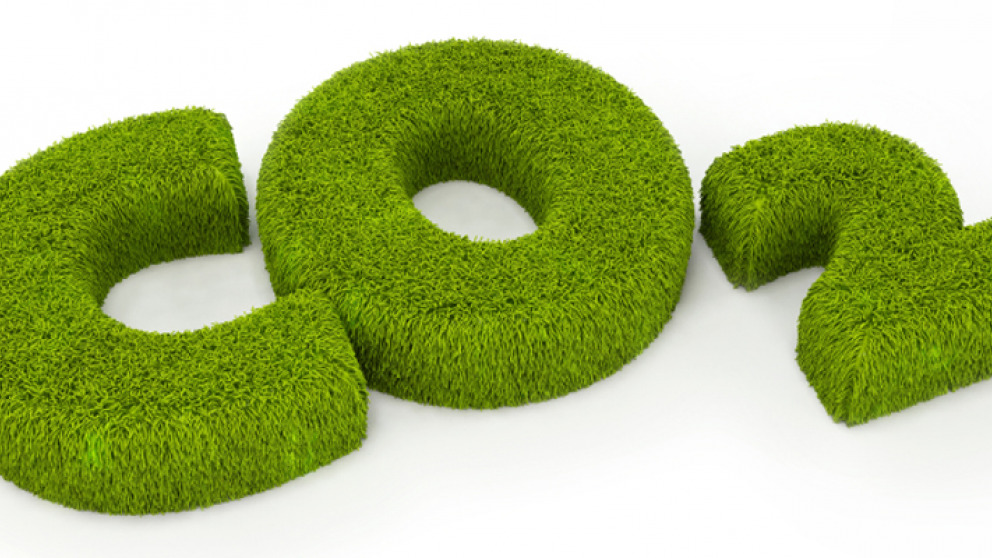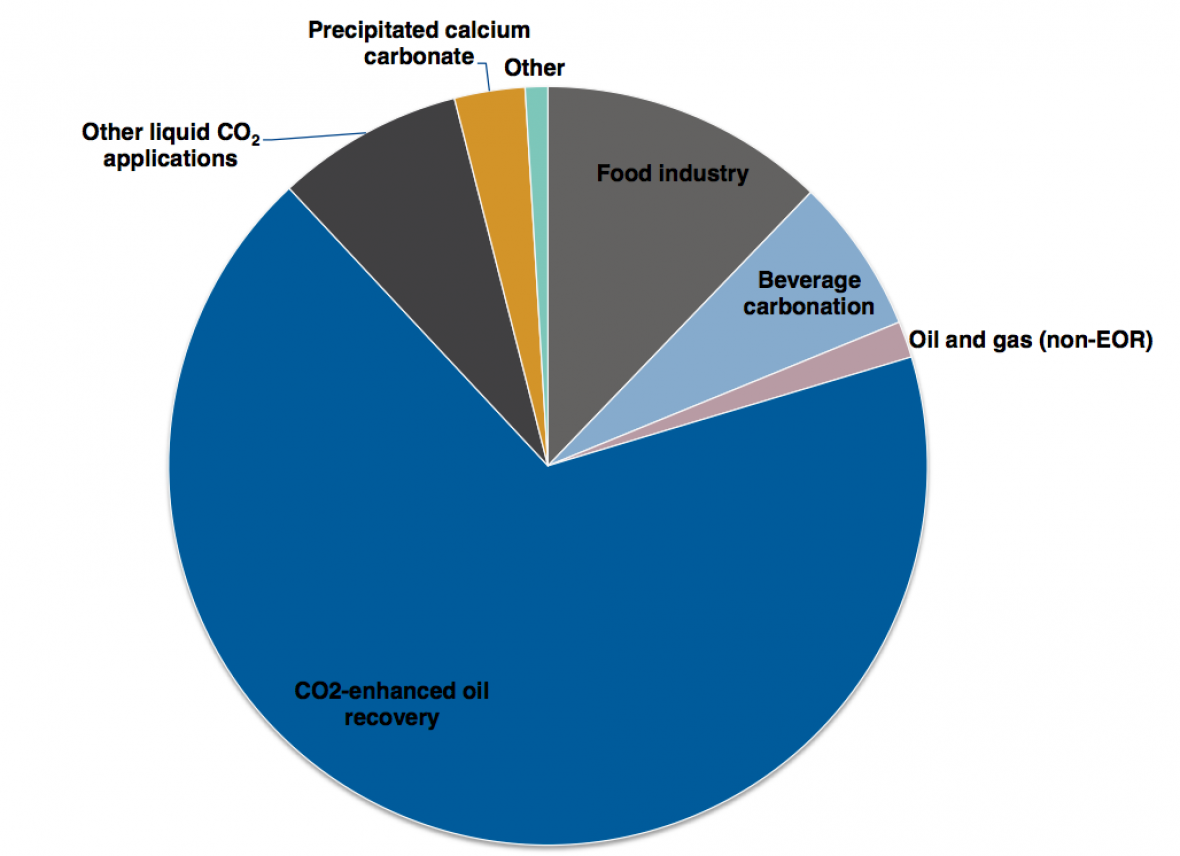Headline:
The CO2 Economy – The Transformation of Carbon Dioxide from a Liability to an Asset

Carbon Capture and Utilisation or Recycling (CCU or CCR) and related technologies could play an important role in a future sustainable and diversified energy supply with lower greenhouse gas (GHG) emissions. CCU entails capturing CO2 from large emitters like coal-fired power plants and re-utilising it to manufacture useful products; as such, CCU represents an alternative to Carbon Capture and Sequestration (CCS). In one approach, CCU can for instance be combined with renewable energy to produce sustainable synthetic fuels.
In a future scenario where CCU would reach industrial maturity and achieve meaningful market penetration, securing access to the required large amounts of CO2 might conceivably become the principal obstacle to further development.
Nowadays, CO2 is used as a raw material only for niche and/or quite localised and heterogeneous applications (see figure 2). As a result, there are no centralised marketplaces for CO2 trading..
The carbon market generally refers to the different instruments that governments use to regulate emissions.
- An emission trading scheme (ETS) – sometimes referred to as a cap-and-trade system – limits the total level of GHG emissions and allows those industries with low emissions to sell their extra allowances to larger emitters. By creating supply and demand for emissions allowances, an ETS establishes a market price for GHG emissions. The cap helps to ensure that the required emission reductions will be achieved, thereby keeping the emitters (in the aggregate) within their pre-allocated carbon budget.
- A carbon tax directly sets the price of carbon by defining a tax rate for GHG emissions or – more commonly – for the carbon content of fossil fuels. It differs from an ETS in that the emission reductions that result from a carbon tax are not pre-defined, in contrast to the carbon price.
In this context, CO2 is not an industrial feedstock but a commodity whose ‘price’ is not directly connected to its value, but rather to financial fluctuations and political decisions. The strong development of CCU-related technologies, and a consequent increase in the demand for CO2 as a raw material, would help transform CO2 from a liability – as it is currently considered in ETS schemes – into an asset for the industrial sector, with an associated market.
![Figure 1 Abb. 1: Vorhandene, entstehende und potenzielle Preisgestaltungsinstrumente für Kohlenstoff (ETS und Steuern) auf regionaler, nationaler und subnationaler Ebene [State and Trends of Carbon Pricing, 88284, The World Bank, 2014]](/sites/default/files/styles/content_image_full_width/public/Figure-1-1.png?itok=3JvW3NHZ)
Current global 'non-captive'[1] consumption of CO2 is estimated to be approximately 80 Mt/year[2], which can be broken down into 25 Mt/year in liquid and solid form and the remainder in gaseous and supercritical form.[3] At present, 50 Mt/year are used for enhanced oil recovery (EOR) in North America.
The existing industrial uses of CO2 (with quite different levels of use) are:
- Enhanced oil recovery
- Food processing, preservation and packaging
- Beverage carbonation
- Steel manufacture
- Pulp and paper processing
- Urea fertiliser production
- Pharmaceuticals
- Other

In addition to the production of sustainable fuels, other emerging technologies would also require bulk CO2 as a feedstock:
- Enhanced geothermal systems (that use CO2 as a working fluid)
- Power generation with CO2 as a working fluid
- Polymer processing
- Algal bio-fixation and biofuel production
- Bauxite residue processing
- Carbonate mineralisation (aggregate production)
- CO2 concrete curing
- Formic acid production
According to estimates that take the current development status of the above technologies into consideration, the demand for CO2 will be 140 Mt/year by the year 2020. Yet the current and expected future demand for CO2 represents only a very small fraction of the total potential CO2 supply from large point sources, which is estimated to be 500 Mt/year for high-concentration sources and 18 Gt/year of diluted CO2 from power, steel and cement plants.
Nowadays, much more CO2 is generated than is recovered. The decision on whether or not to capture the by-product CO2 often depends on the distance and cost of transporting it from the producer to the consumer. For example, it has become profitable to recover CO2 from natural gas wells in Texas because the use of CO2 in secondary oil recovery has increased. The production levels for enhanced oil recovery are generally not reported due to the captive nature of the application.
CO2 price and the cost of capture
The potential supply of anthropogenic CO2 is far greater than the potential demand. It is estimated that around 500 Mt/year of low-cost (<US$20/t), high-concentration CO2 is available annually worldwide as a by-product of natural gas processing, fertiliser plants and some other industrial sources. At a much higher cost (US$50–100/t), around 18,000 Mt could also be captured annually from the diluted CO2 streams currently emitted by power, steel and cement plants.
At present, the price of bulk CO2 is typically agreed in private negotiations between parties and not generally available for public scrutiny.
Some prices are available for the North American market:
- Ammonia producers in the United States are used to a price range of around US$3–15/t for bulk gaseous/supercritical CO2, which varies significantly depending on the location.
- The price for pipelined CO2 has historically been in the range of US$9–26/t, which includes the cost of the pipeline infrastructure (capital and operational costs).
In the case of a developed market for CO2 as a raw material, financial instruments such as ETS and carbon taxes could be pegged to the commodity market price. The price for captured and purified CO2 could be estimated on the basis of certain considerations.
The calculation takes into account the amount of CO2 emitted per unit of electrical energy generated by the power plant, as well as the amount of energy needed to capture one metric ton of CO2 (as a percentage of total energy produced). The ratio between the two, multiplied by the average electricity price, yields the cost in euros of capturing a metric ton of carbon dioxide.
In the case of a pulverised coal power plant, which emits 909 g of CO2/kWh, and assuming 25–30% of the generated energy is needed for the capture processes, the cost of captured CO2 would be €19.8/t at an electricity price of €0.06/kWh.
The cost ranges between €13 to 26/t for electricity prices within the range €0.04 to 0.08/kWh. That could be the approximate lower limit for the price of available CO2 from a fossil power plant coupled with currently available carbon capture technologies.
At present, in Germany and Europe, there is no demand for CO2 as a feedstock for industrial applications, at least for the volumes associated with a retrofitted fossil power plant; the market is limited and localised. Moreover, the sequestration option would not be economically viable given present ETS prices (€8/t).[4]
CO2 Distribution
One of the major obstacles to the development of a CO2-intensive economy is still tied to its distribution. A CO2 distribution network is a major component of a CCU scenario; therefore the cost-effective development of an integrated CCU project will depend on the optimal design of all components, including capture, transport and conversion processes.
Much of the available literature concurs that pipelines will be the most likely option for transporting most of the CO2 that will potentially be required in the decades to come.
Beyond the United States, Canada and Norway, experience of using CO2 pipelines is relatively limited. The United States has more than 6,000 km of dedicated CO2 pipelines, which transport more than 45 Mt of CO2 per year from natural and anthropogenic sources. Almost 75% of them were built in the 1980s and 1990s. By comparison, the network of natural gas pipelines comprises more than 2 million km of pipelines that have been built since the 1950s.
When it comes to developing a CO2 pipeline infrastructure, there are four major challenges:
- Engineering design
- Policy and regulatory issues
- The definition of ‘fit-to-purpose’ standards
- Overall cost and capacity of pipeline investments and financing options
A renewed effort by the international community to facilitate resolutions that allow for the cross-border movement of CO2 will also be highly beneficial for CCU technologies and CO2 pipeline developments in both developed and developing countries.
Conclusion
Given the magnitude and urgency of the climate challenge and the anticipated rapid growth in the industrial use of recycled CO2, a wide range of carbon pricing approaches will be required. Carbon pricing instruments such as carbon taxes, emission trading schemes and crediting mechanisms are vital to internalise the external costs of climate change in the broadest possible way.
[1] Captive use refers to processes in which CO2 is only an intermediate product in a chemical manufacturing process, and where it is ultimately consumed in a later process step (e.g., urea processing).
[2] Where t stands for tonne or metric ton. Mt stands for millions of metric tons.
[3] CO2 can be stored and transported in different states. In supercritical form, CO2 is more chemically stable and reliable.
[4] Price, December 2015.
Header image: istock/Jezperklauzen

Add new comment